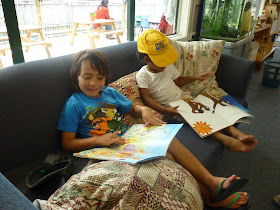"... children's development of literacy grows out of their experiences, and the views and attitudes toward literacy that they encounter as they interact with social groups ..." (Goodman, Y. 1994, p.103).
Oral language, (listening and speaking) is encouraged within an environment in which children can become immersed in sound experiences. Time for uninterrupted play allows for rich texts to develop within the imaginary world of dramatic play. The more free play opportunities that children have, the more they are able to extend play texts through the use of words and objects to represent their ideas.
The development of written and visual language (reading and writing) requires that children are able to view many differing kinds of text and images. A visually rich environment provides opportunities in which ideas about shape, line, and form can develop. Talking to children about shapes, lines, letters, and words help them make important connections between the written and spoken word.
We have found recently that the children's interest in shapes has inspired us to make a variety of geometric images available at the literacy table. With plenty of pens and paper on hand, the children are able to observe images and make marks on paper that are of meaning and relevance to them as individuals.
"Language grows and develops in meaningful contexts when children have a need to know and a reason to communicate" (Te Whariki, Ministry of Education, 1996, p.72).
Art provocations are another medium in which ideas about form, shape, line, and meaning can be introduced and explored with the children. Marks made with brush, pen, or pencil are discussed and admired; important written literacy skills are developed, practiced, and extended.
Rachel.







No comments:
Post a Comment